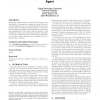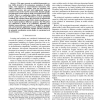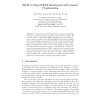16 search results - page 3 / 4 » Evolution of Spiking Neural Controllers for Autonomous Visio... |
ICONIP
2007
13 years 10 months ago
2007
We propose a technique to make a robot execute free and solitary dance movements on music, in a manner which simulates the dynamic alternations between synchronisation and autonomy...
GECCO
2007
Springer
14 years 2 months ago
2007
Springer
Biologically inspired designs can improve the design of artificial agents. In this paper we explain and explore the role of directional light sensors from an Evolutionary Robotic...
CEC
2008
IEEE
13 years 10 months ago
2008
IEEE
Abstract-- This paper presents an artificial homeostatic system (AHS) devoted to the autonomous navigation of mobile robots, with emphasis on neuro-endocrine interactions. The AHS ...
ANTSW
2004
Springer
14 years 9 days ago
2004
Springer
This paper addresses the design of control policies for groups of up to 16 simple autonomous mobile robots (called s-bots) for the cooperative transport of heavy objects of differe...
ICANNGA
2009
Springer
14 years 3 months ago
2009
Springer
In this paper we present application of genetic programming (GP) [1] to evolution of indirect encoding of neural network weights. We compare usage of original HyperNEAT algorithm w...



